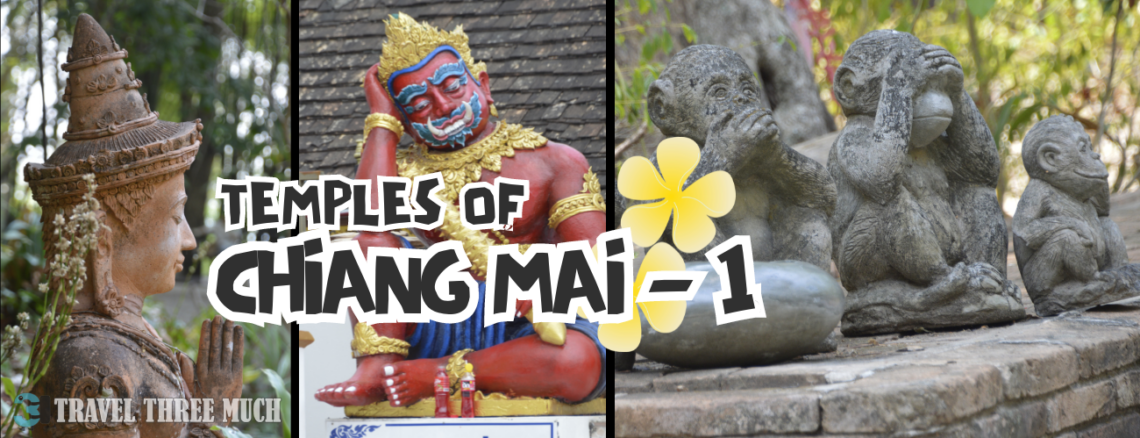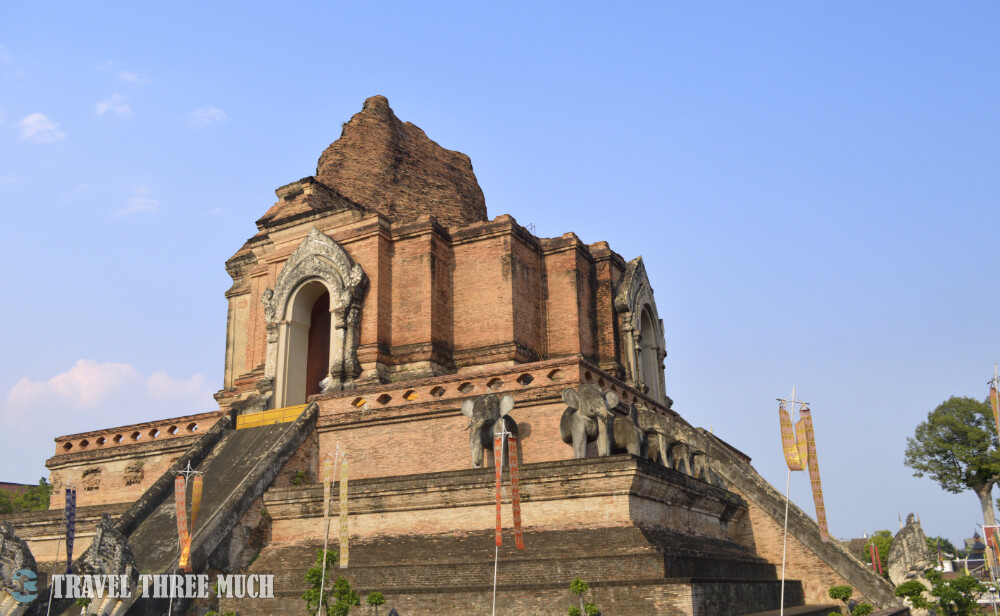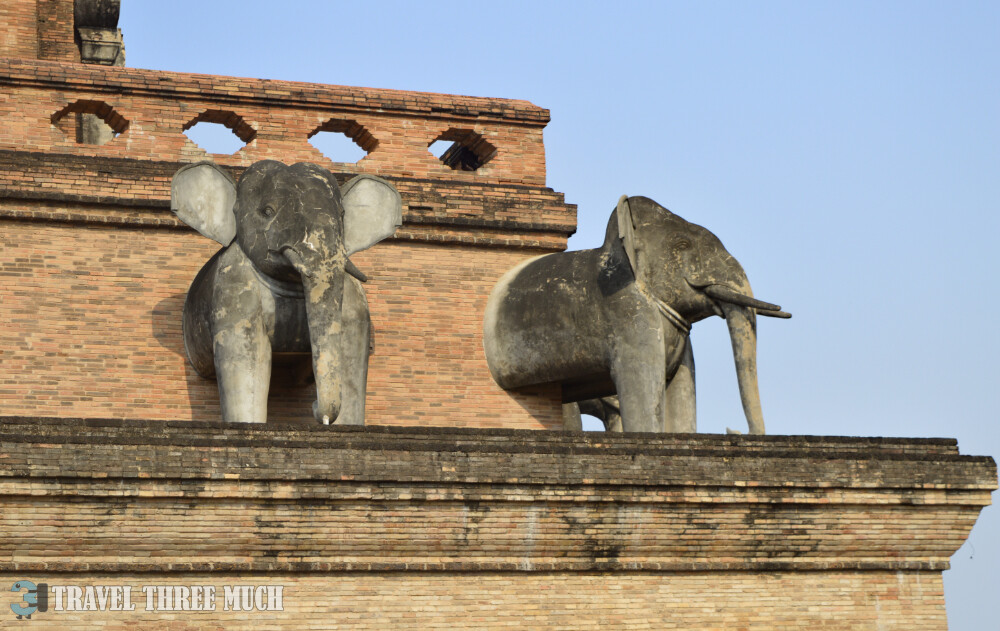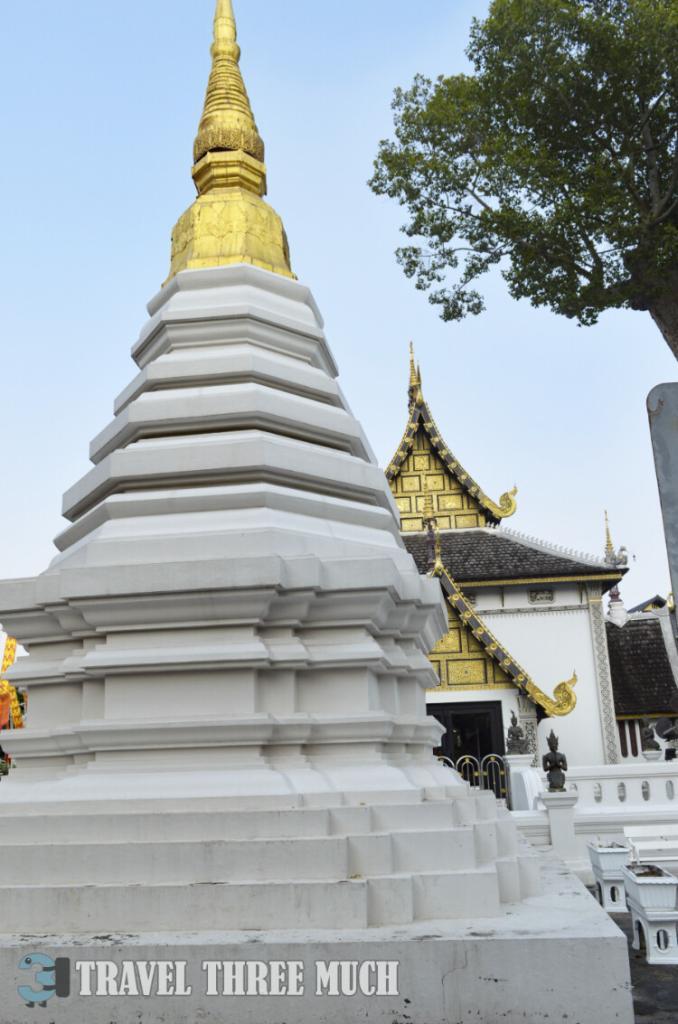
Temples of Chiang Mai: Beyond Tourist Trails – Part 1
Chiang Mai is a city steeped in spirituality and tradition. While we did see glistening golden chedis, it was the intricately carved wooden structures that we were mesmerized by. These structures actually offered a glimpse into Thailand’s rich history and deep-rooted faith. Our journey through the temples of Chiang Mai temples was a profound experience and made us love Chiang Mai even more.
Thai Buddhist temple architecture
In Thai, the word for temple is “Wat.” Thai Buddhist temple architecture features several signature elements that make these structures both unique and fascinating:
- Chedi or Stupa: Bell-shaped reliquaries with variations on the spires that top them. They often house sacred relics and serve as striking centrepieces of the temple grounds.
- Ubosot: The ordination hall, considered the most sacred area of a Wat, where important religious ceremonies happen.
- Wihan/Vihan: The main shrine hall housing the principal Buddha image. It serves as a gathering place for monks and laypeople alike.
- Ho Trai: The temple library or scripture repository, where sacred texts are stored.
Beyond these primary elements, you might find additional structures in Chiang Mai, that add to the temple’s charm and functionality, such as:
- Prangs: Towering spires that often symbolize Mount Meru, the centre of the universe in Buddhist cosmology.
- Mondops: Versatile, free-standing halls used for various purposes.
- Salas: Open pavilions that provide a place for rest and reflection.
- Ho Rakhangs: Bell towers that signal times for prayer and other activities.
- Crematoriums: Facilities for funeral rites.
- Schools and Stilted Houses: Accommodations and learning spaces for monks.
These elements together create a rich tapestry of spiritual and communal life. Each Wat is a hub of cultural and religious significance in Theravada Buddhism.
Wat Chedi Luang

The temple’s name translates to the “Temple of the Big/Royal Stupa” in Thai. Its construction began in the 14th century CE, initiated by King Saen Muang Ma to house his father’s ashes. After the king’s death, his widow continued the work. In the 15th century, the chedi was reinforced to address stability issues.
When completed, the chedi stood 82 meters tall with a diameter of 54 meters, making it the largest structure in Lan Na. It remained a magnificent sight until an earthquake in the 16th century caused the upper third to collapse. Before the quake, the ‘Emerald Buddha‘ resided in the eastern niche, but it was moved to Luang Prabang and later to Bangkok.

In 1990, restoration efforts began to prevent further deterioration. By 1995, a black jade replica of the ‘Emerald Buddha’ was placed in the rebuilt eastern niche, where it remains on display today.
 Plan your trip
Plan your trip
- Construction date: 14th century CE to 15th century CE
- Timings: 6:00 AM to 6:00 PM, open all days
- Entry fee: Free for Thais, 50 THB for adults, 20 THB for children
- Getting there: Tuk-tuk/Songthaew/Taxi
- Note:
- Buddhist temple attire rules apply
- Sao Inthakin and Ubosot halls are off-limits for women
- Don’t miss the weekend market in the lanes outside the temple!
Just beyond this shrine lies the hall with Indra’s Pillar, or Sao Inthakhin, steeped in legend and mystery. The story goes that the Lawa people, who pre-dated Chiang Mai’s founding, received a sacred pillar from the god Indra to protect them from disasters. Later, Indra commanded the pillar’s removal but told the Lawa to create and venerate a replica to ensure the city’s prosperity and protection. The current replica, believed to date back to King Mangrai’s era, was moved to Wat Chedi Luang in the 19th century by King Kawila. This pillar stands as a symbol of protection and prosperity for Chiang Mai. Three soaring dipterocarp trees stand outside the shrine. A sudden fall of any of these trees is considered a harbinger of Chiang Mai’s fall. Women are forbidden entry to this hall.


The massive Wihan was our next stop. The gilded roofing and decorative facing panels with intricate coloured glass mosaic inlays caught the afternoon sunlight and put on a dazzling show of colours. Don’t miss the gigantic bronze Buddha image as well as smaller bronze images of his principal disciples Sariputta and Moggallana on either side, all dating back to around the 14th century.
After taking in the sights of the Wihan, we made our way to the structure giving the temple its moniker – the giant stupa. It is easy to imagine the glorious sight when the chedi was intact. Magnificent roaring Naga bannisters with intricate stucco work frame the staircase on each of the four faces leading up to the niches at the base of the chedi. Climbing any of the staircases on the chedi is forbidden. We could only view the images in the niches from below. In the eastern niche, we could see a black jade Buddha image seated on a red pedestal with gold flourishes. In another niche, a giant golden Buddha image was seated. A library nearby offered a ‘monk chat’ where visitors could interact with the monks and learn more about the Buddhist precepts they study and practice.
We saw several smaller vihans that held the relics and remains of monks and abbots from Chedi Luang’s history. One was Bhuridatto’s vihan. He was known as the supreme mentor of ‘forest monks.’ Another shrine housed a stunning Buddha seated on a five-headed Naga with red gemstone eyes. The side of the chedi directly opposite the vihans has elephant torsos intact at the base of the upper level.

A 20th-century pavilion featuring a five-century-old reclining Buddha caught our attention. The reclining Buddha represents his final moments before liberation from the cycle of birth and death. The Buddha’s face looked serene, free of any worries about his impending demise. In a nearby room, we found a cheerful statue of Katyayana, one of Buddha’s ten principal disciples. Katyayana is renowned for his simplified Buddhist precepts to help laypeople understand them.
Visiting Chedi Luang offered us a glimpse into the grandeur of the Lan Na Kingdom’s achievements and deepened our appreciation for Buddhism’s lasting influence on Chiang Mai’s rich history.
Wat Pha Lat
The towering hulk of Doi Suthep on the western skyline of Chiang Mai is hard to miss. The mountain and the city have such strong historical ties that the famous Wat Phra That Doi Suthep temple atop its peak features on Chiang Mai’s emblem. The mountain has another hidden gem about halfway up its side – the surreal Wat Pha Lat temple. Translating to ‘Temple/Monastery At The Sloping Rock’, Wat Phra Lat has an interesting origin story.

King Kuena (1355 CE to 1385 CE) brought a relic (believed to be a fragment of the Buddha’s shoulder bone) from Sukothai. While riding his white elephant to enshrine the relic at Doi Suthep, the site of Wat Pha Lat was a rest stop for the entourage. The elephant lay down and died from exhaustion when it reached Doi Suthep. The king commanded two temples to be built – one atop the mountain and another at the rest stop.
Wat Pha Lat is a monks’ residence with many spots for quiet meditation.
 Plan your trip
Plan your trip
- Construction date: 14th century CE
- Timings: 6:00 AM to 6:00 PM
- Entry fee: Entry is free for all
- Getting there: Hike through The Monk’s Trail/Songthaew/Taxi
- Note: The Monk’s Trail starts from the Chiang Mai University at the foothills up to Wat Doi Suthep. However, the trail becomes steeper after Wat Pha Lat. It’s about an hour from Chiang Mai to Wat Pha Lat and another hour and a half to Wat Doi Suthep via this trail.
There was one stall selling young coconuts and soft drinks at the entrance to Wat Pha Lat. So, pack water and snacks if you plan to trek through The Monk’s Trail.
We wanted to make the most of our temple run. We skipped the trek and hired a taxi from Chiang Mai, combining Wat Pha Lat and Wat Umong. The road wound its way up the mountain and the temperature dropped steadily. Despite the steep incline, we could see cyclists braving their way up the mountain road. Wat Pha Lat has ample parking. We saw preparations underway for an ordination ceremony (Buat Nak in Thai). This ceremony is to ordain a man into a monastery when he turns 20. A period of dharma study (between a week and a month) follows this ordination to make merit for the ordained and his family.

Entering the temple was like stepping through a portal into another world, which time had forgotten. Grey and white stucco statues of four-armed fantastic guardians greeted us – human torsos and serpent bodies with one arm on a sword hilt and another brandishing a trident. A mixture of welcoming gestures with a subtle warning of consequences for malice! Another wall with a stucco panel of a frolicking elephant on its back, holding a lotus blossom in its trunk, all overgrown with ivy seemed to hint at the temple’s legendary beginning.
Just past this entrance was the viharn – shrine hall with the Buddha images. The temple had fallen into disrepair and was reconstructed under the patronage of a Burmese merchant. History seemed to have come full circle – the Burmese sack devastating Ayutthaya in one part of the country, and here in another part, a Burmese-sponsored recovery of the temples from the wilderness. Large black Buddha images were enshrined in the structure. Statues of Maitreya, the future Buddha, and Kuan Im, the goddess of mercy, stand watch over the city from the hillside.
Here and there amid the foliage lay scattered an array of whimsical takes on deities – a snoozing Garuda kept company by a monkey, an impish Thao Wessuwan, a slumbering diminutive giant from the legend of Wat Phra Thot Doi Kham, and so on. Other sculptures, like a cute baby elephant half-hidden among dry leaves and a laughing infant holding a frangipani blossom, added to the surreal atmosphere.



Stairs guarded by truncheon-wielding figures led to the chedi adjoining the shrine hall. The outer stucco has weathered away, exposing the underlying brickwork. Central niches aligned with the cardinal directions at the base of the chedi had enshrined Buddha images. Serpentine frog-faced beasts, called Dtuwamaum in Thai, guard the niches. Half-woman half-lion mythical creatures, called Apsonsi in Thai (compounded from Apsara and Singha), stood watch from atop the chedi.
The Burmese influences are evident in the snarling Chinthe figures at the chedi’s corners, likely reflecting the restoration patron’s heritage. Nearby stood a white Buddha shaded by a parasol, flanked by two disciples.
An alcove crowned by a stucco peacock featured a tranquil pool, fed by a gentle brook, with a coconut shell on a bamboo pole for making water offerings to the Buddha images.
A white pavilion, with its moss-covered facade, had panels showing an archer and riders on lion-like figures at its base. Inside, a large reclining Buddha flanked by seated Buddha images filled the cavern. From inside, we could see decorated door panels likely from the original structure, which had tremendously weathered and the vibrant restored artwork from the renovated shrine – all in Lan Na style.


A black dog cooling off in the stream joined us and led us to a small shrine across a bridge flanked by kneeling Thewas (angels in Thai). At the shrine, we sat quietly for a while, contemplating the Buddha image and the prayer instructions in Thai. Next, we ventured onto the Monk’s Trail briefly to explore the path before backtracking to the shrine.
From here, we made our way to a platform with two sets of staircases – one going up and another down a sloping hillside. The descending staircase was flanked by antlered Naga balustrades, leading to a small chedi-like structure perched on the rock. We climbed back up to the platform where a pair of antlered Chinthe, resembling Chinese Pixiu, guarded the staircase to the entrance level.

Inside the open mouths of the giant figures were images of Phra Upakut, a revered monk in Burma, Laos, and Northern Thailand, symbolizing benevolence and good luck. Phra Upakut intercedes with the Buddha on behalf of sinners. The smiling monk with the upturned face inside the gaping maws of the menacing giants was a strange sight to behold!

The ordination ceremony for the young monk was over when we were leaving. We cooled off with some chilled ‘young coconut’, which had a smoky taste and a singed shell. We asked the seller about this. She explained that burning the outer shells of coconuts enhances the sweetness of both the flesh and the water inside them.
We saw a temple at the entrance, which we had skipped to avoid crowds. Two Apsonsi on either side of the entrance guarded the shrine. A large Buddha sat inside the temple, with a Buddha footprint in front of the image. Another shrine had an image of the Buddha with colourful murals decorating the walls.
We bid adieu to the otherworldly Wat Phra Lat and set off to our next stop – the sprawling Wat Umong.
Wat Umong
Wat Umong, also known as Wat Umong Suan Puthatham, is over 700 years old. It was built by King Mangrai, the founder of the Lan Na Kingdom. Nestled against the Doi Suthep mountain, the temple sprawls over many acres and includes living quarters for monks.
There are a couple of legends about the temple’s origins. One suggests that in the 13th century, King Mangrai built it to accommodate forest monks from Sri Lanka. In another story, King Kue Na, in the 14th century, consulted a monk named Therachan, who lived in the old city temple. As Chiang Mai expanded, Therachan struggled to find quiet places to meditate and started practising in forests, which led people to see him as a bit eccentric. King Kue Na commissioned the temple in a tranquil forest near Doi Suthep to keep Therachan nearby for consultation. It is said that the temple was mysteriously abandoned in the 15th century. It only started functioning as a monastery again in the 20th century after restoration in 1948 CE.
 Plan your trip
Plan your trip
- Construction date: 13th century CE
- Timings: 6:00 AM to 5:00 PM
- Entry fee: Free for all. The tunnels and the sculpture garden have a 20 THB per person charge for non-Thai visitors, payable at the entrance opposite the sculpture library.
- Getting there: Songthaew/Taxi
- Note:
- There are two temples with similar names – Wat Umong. One in the old city named Wat Umong Maha Thera Chan and another near Doi Suthep, named Wat Umong Suan Puthatham.
- Ensure you have the correct Wat Umong agreed with your driver if you’re planning a visit by taxi/songthaew.
- It’s not easy finding a ride back from this location. So, it may be a good idea to plan a return trip with your ride and pay them for the waiting time at the temple.
- If you’re claustrophobic, you may want to skip the tunnels as some parts are not well-lit, and some niches are quite narrow.
At the entrance, a map of the temple complex clearly labels all the important sights. One of the first sights that greeted us was the trio of monkey sculptures with their ears, eyes and mouth closed. For Indians, this image is well-known thanks to a Japanese Buddhist monk’s gift of this sculpture to Gandhi. Here, a smiling baby monkey joined the usual trio. We climbed up a Naga balustraded staircase to reach the temple’s chedi. The massive spire built in Sri Lankan style lends weight to one of the origin tales of the temple.


We descended to the tunnels directly beneath the chedi and explored them for a while. The lighting shifted dramatically thanks to skylights scattered throughout the tunnels. The passages branched off in different directions, ending in niches. Some niches housed serene Buddha images, while others were empty. Legend has it that the walls were once adorned with murals of forest scenes to keep the monk Therachan from wandering off into the woods.


We came out to the ground level and found a casting of an emaciated Buddha. The detail on the sculpture was incredible – muscles, veins and bones showing through the stretched skin. The sculpture was in Burmese style. It was unclear if the scene was from the initial days of Siddhartha as he tried the ways of ascetics to see if it led to nirvana or if it was from a later stage of his life, after becoming the Buddha.
We visited the sculpture garden. Here, fragments of Buddha sculptures, including a giant head, have been collected from various sites and displayed. There was also a replica of the Ashoka Pillar from India, honouring his role in spreading the Dhamma across India and neighbouring regions. We found the ‘Talking Trees’ with placards with wisdom from diverse sources. These ranged from Forrest Gump to the Dhammapada, written in both Thai and English.
On the way to a lake teeming with giant catfish, turtles, and pigeons, we encountered a statue of Buddhadhasa Bhikkhu, one of Thailand’s most celebrated 20th-century monks and a significant influence on the temple. You could buy bread to feed the animals, to make merit or simply friends! Unfortunately, the spiritual theatre, a gallery of murals, was closed during our visit, marking the end of our trip to Wat Umong.

We took a cab to Pure Vegan Heaven, conveniently close to Wat Umong, for lunch. The food was excellent, with generous portion sizes. Full and refreshed, we set off to the next stop for the day – Wat Phra That Doi Kham.
Wat Phra That Doi Kham
Wat Phra That Doi Kham or the Temple of the Golden Mountain in Thai, has a magnificent golden chedi dating from 687 CE. Legend has it that the Buddha parted with a strand of his hair to make two giants on the hill give up their cannibalistic ways. Queen Camadevi’s sons built the chedi to house several relics, including the strand of the Buddha’s hair. In 1966 CE, heavy downpours caused the chedi to collapse, revealing the Buddha images and relics inside. The locals quickly rallied, raising funds to rebuild both the temple and the chedi.
 Plan your trip
Plan your trip
- Construction date: 7th century CE
- Timings: 8:00 AM to 5:00 PM
- Entry fee: Free for Thai citizens and 30 THB for non-Thai visitors
- Getting there: Walk/Taxi/Songthaew
- Note:
- It’s possible to climb about 300 steps to reach the temple from the base. If you’re planning to trek to the temple, start early to beat the crowds and heat.
- It’s not easy finding a ride back from this location. It may be a good idea to plan a return trip with your ride and pay them for the waiting time.
- Dress appropriately as Buddhist temple rules of attire apply.
We arranged with our driver to visit Wat Phra That Doi Kham, Wiang Kum Kham, and Wat Sri Suphan before returning to our stay in the old city of Chiang Mai. This way, we avoided the hassle of finding rides from remote locations like Doi Suthep and didn’t have to wait for transportation. Wat Phra That Doi Kham has ample car parking at the top.

The magnificent viharn with the gilded Naga guarding it was the first sight that greeted us. A seated Buddha figure towered over the viharn. A pavilion near the Buddha had statues of a guardian yaksha, a couple of elephants, an Ardhanarishwara (half-Siva and half-Parvathi), and a bejewelled monkey king.
Inside the temple, a row of Buddha images in a roofed passage to one side. On another side, sculptures of Phra Upakut, and a sleepy giant from the origin story of the temple greeted us. A bejewelled yaksha flanked by serpentine Naga stairways guarded the entrance to the golden chedi in Lan Na style. The chedi houses the Buddha relic.

We reached a platform that would’ve been the entrance for those making the trek to the temple, offering panoramic views of the valley and the city. There are several spots are thoughtfully created for photography around the temple at this entrance. We also saw deities from the Hindu pantheon such as Vishnu, Brahma, Siva and Ganesh depicted in sculptures and murals.
When we reached the parking, our eyes caught a winding mural. The mural depicted a captivating Hindu legend with gods and demons churning the cosmic ocean with a giant serpent as their rope. The Meru mountain (a key concept in Thai Buddhism) is their churn, and Vishnu in his tortoise is the base. Brahma and Shiva watched as Vishnu stood atop the churning mountain. The gods had flaming halos, while the demons wore churlish expressions, their poses reflecting the immense strain of the churning.

Our driver surprised us with a tasty treat: Fresh Chiang Mai corn on the cob. We savoured the delicious snack and mulled over the temple’s scenes on our way to Wat Sri Suphan.




